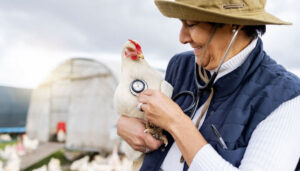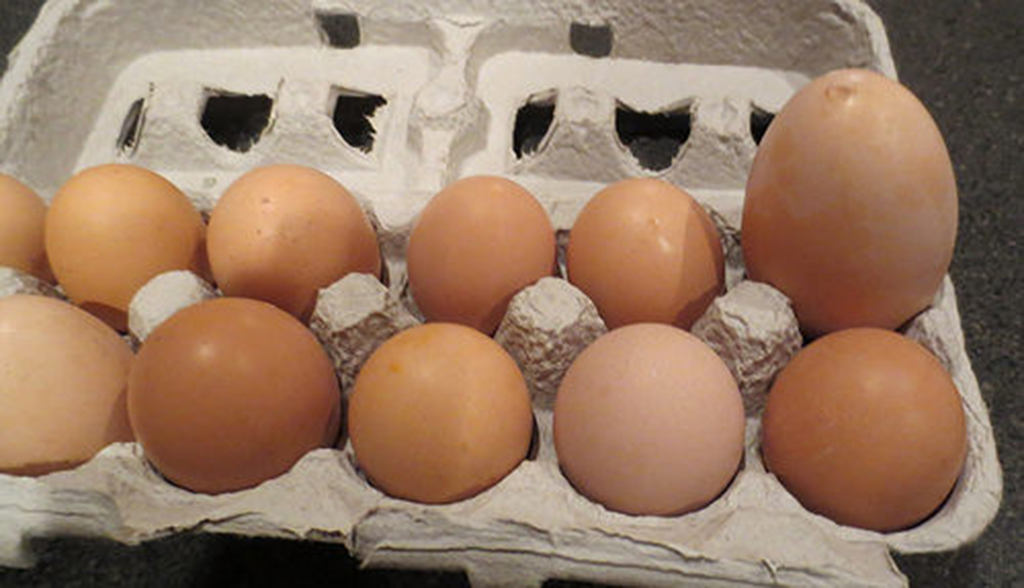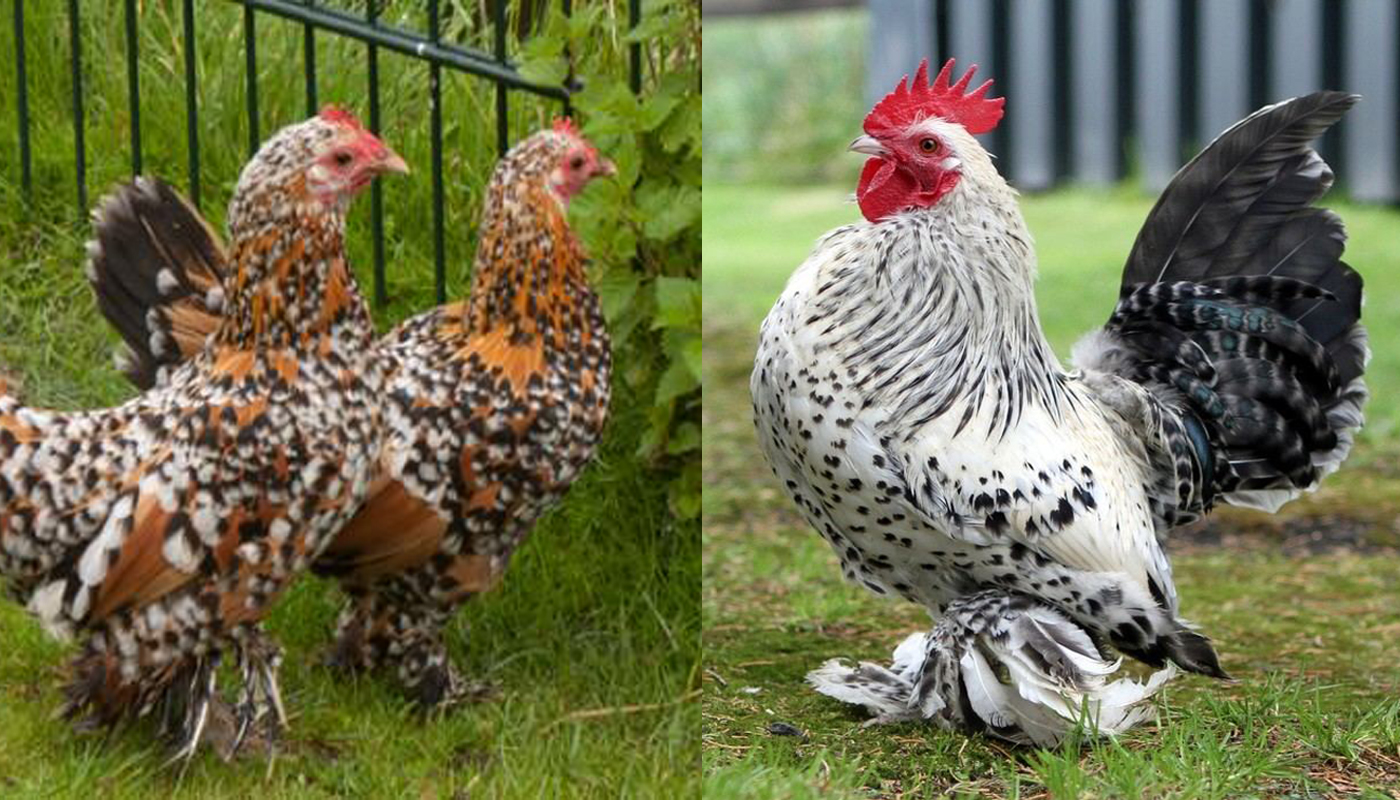
The Andalusian is quite a rare bird these days but if you can find them they make a great addition to a flock. They are really good egg layers and their white meat makes for a tasty table chicken. The breeds status is listed as threatened because there are not that many lefts but are making a bit of come back. These birds are being bred by hobbyist trying to preserve the breed. They are a really good all-around chicken their beautiful plumage with its lacy markings make it an excellent show bird, they lay a good amount of eggs all year, they are a friendly chicken and are also a good table chicken.
For first-time chicken owners, this bird would greatly compliment your flock. Breeding these chickens, however, is best left to those who have worked with these birds having the blue gene makes them not breed true.
HISTORY
The Andalusian is quite an ancient breed, so a lot of its history is not that well known. The bird originated in Andalusia in Spain and was first exhibited in the United Kingdom in 1853.
They were also imported to America in 1853 but were only accepted into the American Poultry Association Standard of Perfection in 1874. As to date, only the Blue Andalusians are recognized by the organization. The creation of the Blue-laced Andalusian is attributed to two breeders in England, namely Coles and John Taylor. The breed was first shown in Germany in 1870 the same year the bird was exported to South America.
The Andalusian Bantam was created in the 1880’s.
The bird has been known as the Andalusian, Blue Andalusian or Andaluza Azul (Spanish name). The chicken’s numbers had steadily declined to a mere 10000 in 2009 but the numbers are on the rise again thanks to the many poultry clubs around the world.
CHARACTERISTICS |
|
|---|---|
| Country of Origin: | Spain |
| American Poultry Association: | Recognized as a breed of chicken in the United States |
| Chicken Category: | Large Breed |
| Chicken Class: | Mediterranean |
| Bantam Variety Available? | Yes |
| Related | TOP 10 BANTAM CHICKEN BREEDS FOR BEGINNERS |
IDENTIFICATION⇒ |
Appearance: They have a compact somewhat rugged body, white skin with clean legs
The roosters have soft feathers adorning their backs that make them look like they are wearing a jacket and have sweeping tail feathers. The Andalusian feathers look like they are covered in lace. The female has upright tail feathers and no
Color(s): The Blue Andalusian is the only color recognized by the APA.
Comb: They have a single comb
Ave. Weight: Hens/Pullet 5.5 lbs.
Cockerel 7 lbs. |
| Life Expectancy: | The average lifespan is 8 – 12 years depending on their environment. |
| Good Starter Chicken? | If you can get some of these chickens, they are great for first-time chicken owners as they are not a high maintenance bird. |
| Related | 10 BEST STARTER CHICKENS FOR THE FIRST TIME POULTRY KEEPER |
PURPOSE⇒ |
Eggs: Good layers that lay consistently all year round.
They lay large white eggs up to 160 per year They start to lay eggs from around 5 to six months old.
Meat: The Andalusian white meat is rarely tasty and makes a great table bird.
Breeding: They hens do not become too broody although they will brood for a while.
If you are breeding the Andalusian it is best to seek advice from a registered breeder. If you are looking to breed Blue Andalusians bare in mind that two Blue Andalusians will not always breed true. You are likely to get around 25% black, 25% splash and maybe 50% blue. The baby chicks baby chicks hatch out in black, splash and blue. For advice on breeding please check our guide to breed poultry. If you are a first-time breeder it is best to get professional advice from your local registered Andalusian breeders, animal shelters, poultry farmers or vet.
Foraging: Foraging is this chicken favorite hobby, so they will need a bit of space to do so.
Show Bird: The Andalusian makes a beautiful show bird with its unique plumage.
Pets: They make wonderful pets
Other: This chicken will keep you company in the garden. They are a very lively, active and chatty chicken with an abundance of curiosity.
They will give your organic garden a lot of nutritious fertilizer to ensure great blooms and tasty vegetables. |
| Health: | Other than being prone to frostbite they are a very hardy healthy bird. |
| You may Also Like: | HOW TO TELL IS A CHICKEN IS SICK |
| Temperament: | They are sweet gently birds that can be a bit skittish if a person tried to pick them up. But they do not mind human company and are not opposed to a bit of petting. |
| Flyers? | Good flyers that’s curious nature will have them hoping your fence. |
| Noisy Birds? | They can be noisy birds as they do love to have a good chat. |
| Interaction with other chickens: | Andalusians work well if they have been socialized with their flock from young. They can be a bit aggressive towards other hens and will need time to adjust to any new flock members or a new flock if introduced as an adult. As with any flock if you are introducing new birds it is best to slowly socialize them with the flock. |
| Good with kids? | They are quite good with kids as they are an adventurous chicken that delights in finding out what is going on. |
| Related | 10 ROOSTER BREEDS THAT DO NOT MIND CHILDREN |
| Socialize Behavior? | Andalusian chickens can be a bit flighty and skittish around other domestic animals. They should get used to them though after some time. |
| You may Also Like: | HOW TO SOCIALIZING YOUR NEW CHICKENS |
| Known predators: | Most domestic animals leave them alone, but it is always best to keep an eye on dogs and cats. If hawks and or foxes are in your area it is always best to take precautions. Check with local animal shelters, zoos, vets, animal control and or pet stores about common predators in your area. |
| Conservation Status: | These birds are quite rare with their conservation status being recorded as “threatened”. It is best to check on any special license or instructions that may be set up for owning these birds. This can be checked with your local or national conservation centers. |
IDEAL ENVIRONMENT⇒ |
Garden Size: They can be confined but do not take to it that well they become restless, noisy and disruptive. Foraging around free-ranging is best for them. They need a medium to large size garden with spaces to roam and explore.
Ideal Climate: They do better in the heat than they do in the cold. They will adapt to the cold but are prone to frostbite.
Ideal Coop: The rule of thumb for any coop is 50 cm x 50 cm per hen/rooster in the coop.
Ensure there is a good space for the nesting boxes and nightly roosting rails at least 1.5 inches wide. Good ventilation for air but not too drafty especially in winter. It is always a good idea to raise the coop off the ground to give the birds a dry place to roost and lay especially in wet weather.
Ideal Coop Run: The run should be completely covered with a chicken mesh as these birds love to fly and have no problem hopping the fence to visit the next-door garden.
Ideal Flock Size: Andalusian chickens love to socialize and chat with the flock, so you will need more than one bird.
Special Instructions: Hardy birds that do not need any special attention, but they do like their human’s company.
Accessories: The following accessories are ideal for your coop:
Nesting boxes Straw for the boxes and roosting area Roosting rails Perches Water troughs/bowls Food bowls/feeders Heating lamp(s) Animal carrier for transport purposes |
| You may Also Like: | 45 FREE DIY CHICKEN COOP PLANS, TUTORIALS AND DESIGNS |
WHERE TO FIND THESE BIRDS TO ADD TO YOUR FLOCK
As quite a rare breed these days you will mainly find them at certain hatcheries and breeder clubs around the United States. Check with the livestock conservancy for information on breeders in or around your area.
You can find some Andalusians at various poultry outlets and farms, if you are planning on breeding them or showing them, it is advisable to check the bird’s lineage.
If you are not going to show them or breed them you can get the black or splash colored Andalusian chickens as they are just as beautiful as their Blue Cousins.
CARING FOR THE BIRD(S)
Please click here for our full guide to “Taking care of chickens”. This is a comprehensive guide to owning chickens. It covers where to start from choosing your ideal flock, the coop that would best suit your garden, your bird and you to buying and bringing your bird(s) home.
GENERAL
They make lively, energetic and adventurous pets. You are sure to get many hours of joy out just watching them romp around the garden. Being quite a noisy bird, it is best to check with your neighbors first before committing to these birds. As they are listed in the Poultry conservation you may need to check if there are special licenses, etc. you may need in order to own these chickens.
GROOMING
Andalusians need to be checked at least once a week for mites, lice and various other parasites. All domestic animals need to be de-wormed on a regular basis and this includes your chickens. Check with your local vet for the best de-worming or worm prevention medication for your chickens. There are a lot of natural remedies that can be tried.
As they like to have domain over the garden setting up one or two nice shady dust baths for them will go down really well. There is nothing like watching chickens take their dust bath which helps them get rid of nasty pests and excess oils.
DIET AND NUTRITION
Some nice ice-cubed vegetables or fruit in the summer is a great treat for your chickens. They will never turn down some nice table-scraps. There regular food of either chicken pellets, grains, chicken mash or grain mix from 8 weeks old and older should always be given to them before they go out to forage for the day.
For baby chickens, the best is always Chick Starter when they are under 8 weeks old.
Laying hens should get extra protein and calcium in their diets to ensure the quality of their eggs and to keep them in tip-top health.
Please see our comprehensive guide to “Feeding your chickens” for more information of the different types of chicken feed for chicks, hens, laying hens, roosters, etc. and where to buy the feed and approximate cost of the feed.
SOCIALIZING THE BIRD(S)
Although Andalusians are social birds they have a very strict pecking order and can be quite aggressive towards new hens in the flock. It is best to ensure that any new chickens you are introducing to the flock have a nature that will compliment your flock of Andalusian ladies. The roosters have also been known to be very territorial so try only ever have one rooster. The Andalusian roosters are also extremely vocal cocks and are not recommended for the quieter neighborhoods.
Always check on how well a breed will get on with your current flock before buying them as you do not want to upset your coop or stress your current flock.
If you want to introduce another breed with you Andalusians it may be best to introduce a breed that is hardy and not shy to stand up for itself.
As with any newcomer to the roost, you will have to quarantine the bird for 7 – 31 days to ensure it does not have any unwanted critters or disease that could spread to your current flock.
NOTES / SPECIAL INSTRUCTIONS
As they are registered as a “threatened/watch” conservation status they may need an extra license to own or keep in your garden. For advice on what the bird’s conservation status and orders are please check with your local conservation department.
For breeders, it is imperative that you always check your bird’s bloodlines and ensure you are buying your birds from a reputed breeder/farm. In order to sell birds of such stature, they have to be recorded and documented, always check with local animal breeding organizations for these records.
These legitimate documents are also required should you wish to show your bird(s) in various poultry shows/competition showings.
For information and advice on adopting rescued animals, you can visit or contact your local animal welfare center.
Video
USEFUL LINKS
- Caring for your Chicken
- Feeding
- Health
- Socializing your Chicken
- Breeding Chicken
- Raising Chickens A-Z
- Hatching Eggs
- What is Molting
- Animal Shelter (ASPCA)
- American Veterinary Medical Association
- American Poultry Association
- American Animal Welfare Society
- American Animal Control
- American Animal Husbandry Society
References
- https://en.wikipedia.org
- https://livestockconservancy.org
- https://www.roysfarm.com
- https://www.mypetchicken.com
- https://www.backyardchickens.com
- https://www.feathersite.com/
 10 of the Most Rare Chicken Breeds
10 of the Most Rare Chicken Breeds Cochin Chicken Breed – Everything You Need to Know
Cochin Chicken Breed – Everything You Need to Know Ameraucana Chicken Breed – Everything You Need to Know
Ameraucana Chicken Breed – Everything You Need to Know The Basics of Chicken Health: Understanding Common Ailments and Prevention Strategies
The Basics of Chicken Health: Understanding Common Ailments and Prevention Strategies Cubalaya Chicken Breed – Everything You Need to Know
Cubalaya Chicken Breed – Everything You Need to Know 10 Chicken Breeds that have White Plumage
10 Chicken Breeds that have White Plumage American Game Fowl Chicken Breed – Everything You Need to Know
American Game Fowl Chicken Breed – Everything You Need to Know Settling the Flock into their New Home
Settling the Flock into their New Home Delaware Chicken Breed – Everything You Need to Know
Delaware Chicken Breed – Everything You Need to Know Top 10 Jumbo and Extra Large Egg Laying Chicken Breeds
Top 10 Jumbo and Extra Large Egg Laying Chicken Breeds Booted Bantam Chicken Breed – Everything You Need to Know
Booted Bantam Chicken Breed – Everything You Need to Know La Fleche Chicken Breed – Everything You Need to Know
La Fleche Chicken Breed – Everything You Need to Know